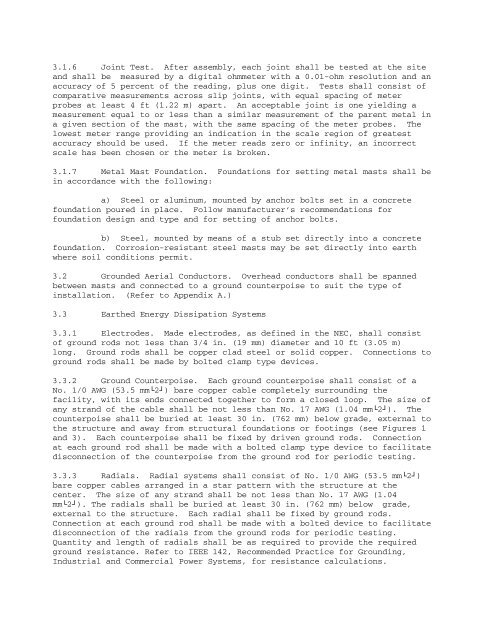NAVFAC MIL-HDBK-1004/6 Lightning Protection
NAVFAC MIL-HDBK-1004/6 Lightning Protection
NAVFAC MIL-HDBK-1004/6 Lightning Protection
Create successful ePaper yourself
Turn your PDF publications into a flip-book with our unique Google optimized e-Paper software.
3.1.6 Joint Test. After assembly, each joint shall be tested at the siteand shall be measured by a digital ohmmeter with a 0.01-ohm resolution and anaccuracy of 5 percent of the reading, plus one digit. Tests shall consist ofcomparative measurements across slip joints, with equal spacing of meterprobes at least 4 ft (1.22 m) apart. An acceptable joint is one yielding ameasurement equal to or less than a similar measurement of the parent metal ina given section of the mast, with the same spacing of the meter probes. Thelowest meter range providing an indication in the scale region of greatestaccuracy should be used. If the meter reads zero or infinity, an incorrectscale has been chosen or the meter is broken.3.1.7 Metal Mast Foundation. Foundations for setting metal masts shall bein accordance with the following:a) Steel or aluminum, mounted by anchor bolts set in a concretefoundation poured in place. Follow manufacturer's recommendations forfoundation design and type and for setting of anchor bolts.b) Steel, mounted by means of a stub set directly into a concretefoundation. Corrosion-resistant steel masts may be set directly into earthwhere soil conditions permit.3.2 Grounded Aerial Conductors. Overhead conductors shall be spannedbetween masts and connected to a ground counterpoise to suit the type ofinstallation. (Refer to Appendix A.)3.3 Earthed Energy Dissipation Systems3.3.1 Electrodes. Made electrodes, as defined in the NEC, shall consistof ground rods not less than 3/4 in. (19 mm) diameter and 10 ft (3.05 m)long. Ground rods shall be copper clad steel or solid copper. Connections toground rods shall be made by bolted clamp type devices.3.3.2 Ground Counterpoise. Each ground counterpoise shall consist of aNo. 1/0 AWG (53.5 mmÀ2Ù) bare copper cable completely surrounding thefacility, with its ends connected together to form a closed loop. The size ofany strand of the cable shall be not less than No. 17 AWG (1.04 mmÀ2Ù). Thecounterpoise shall be buried at least 30 in. (762 mm) below grade, external tothe structure and away from structural foundations or footings (see Figures 1and 3). Each counterpoise shall be fixed by driven ground rods. Connectionat each ground rod shall be made with a bolted clamp type device to facilitatedisconnection of the counterpoise from the ground rod for periodic testing.3.3.3 Radials. Radial systems shall consist of No. 1/0 AWG (53.5 mmÀ2Ù)bare copper cables arranged in a star pattern with the structure at thecenter. The size of any strand shall be not less than No. 17 AWG (1.04mmÀ2Ù). The radials shall be buried at least 30 in. (762 mm) below grade,external to the structure. Each radial shall be fixed by ground rods.Connection at each ground rod shall be made with a bolted device to facilitatedisconnection of the radials from the ground rods for periodic testing.Quantity and length of radials shall be as required to provide the requiredground resistance. Refer to IEEE 142, Recommended Practice for Grounding,Industrial and Commercial Power Systems, for resistance calculations.
















